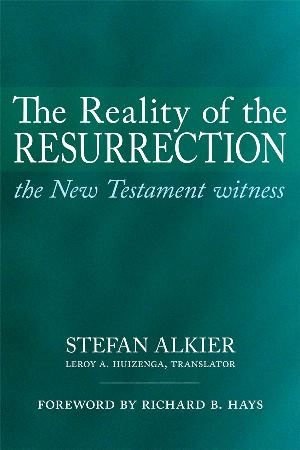Stefan Alkier: The Reality of the Resurrection
 Stefan Alkier, The Reality of the Resurrection: The New Testament Witness (Waco: Baylor University Press, 2013), 351 pages.
Stefan Alkier, The Reality of the Resurrection: The New Testament Witness (Waco: Baylor University Press, 2013), 351 pages.
This book takes an in-depth look at the resurrection of Jesus, as it figures in the writings of the New Testament and in the Church’s subsequent use of the resurrection as an idea. Alkier begins by taking a close look at the resurrection in Paul’s writings, and he shows, at every turn, that Paul’s gospel was contingent upon the “reality” of the resurrection. The connection between the resurrection and the saving power of the gospel can also be gleaned from the remaining books, although it is laid out in a less direct way.
After five chapters of exegesis on Paul, Hebrews, the Synoptic Gospels and Acts, the Johannine Writings, and the Catholic Letters, Alkier presents four chapters of “systematic interpretations”. Here the book takes a rather odd turn, as Alkier calls on the semiotic theory of Charles S. Peirce to examine the phenomenology of the resurrection in terms of “firstness”, “secondness”, and “thirdness”. It is not altogether clear what is to be gained by this. Perhaps if Alkier had spent more time selling the reader on Peirce’s ideas, and on explaining their value, there might be more to say in their behalf.
In connection with this use of Peirce, there arises a significant concern in the guise of Alkier’s continual attempt to sideline the importance of the “empty tomb”. At this point, we are led to wonder whether “reality”, as it appears in the book’s title, really means reality (The knowing reader cannot help but recall Luke Timothy Johnson’s ill-fated attempt to redefine the word “real” in relation to “the real Jesus”). There is a foreshadowing of Alkier’s misgivings already on page 1, where the posing of questions about the emptiness of Jesus’ tomb and the objectivity of the resurrection appearances is said to amount to an “extensive reduction of the discussion”. As we see later on, these historical questions are, for Alkier, not merely the pincers of a reducing movement, but wholly dispensable aspects. Naturally, this is a disappointment for those who might want to believe that “reality” means reality.
In the third and final section of the book, Alkier discusses the resurrection in relation to “ecclesial and educational praxis”, including its role as a theme in the funeral service, in “religious school instruction”, and in the Lord’s Supper. From Alkier’s point of view, it makes sense that the discussion of Peirce should intervene between the exegetical chapters and the application of the resurrection as an idea within the church. The semiotic analysis, in a way, “processes” the resurrection for its use in the church.
Those interested primarily in learning what the New Testament says about the resurrection can profit from reading the first five chapters. That, after all, is what the book’s subtitle suggests the book is about. Beyond that, it’s difficult to say what one might find of value. Without more explanation of why Peirce’s ideas move us forward, it’s difficult to see what they add.
Reviewed by John Poirier
Publisher’s page: http://www.baylorpress.com/Book/387/The_Reality_of_the_Resurrection.html
Category: In Depth, Spring 2016


